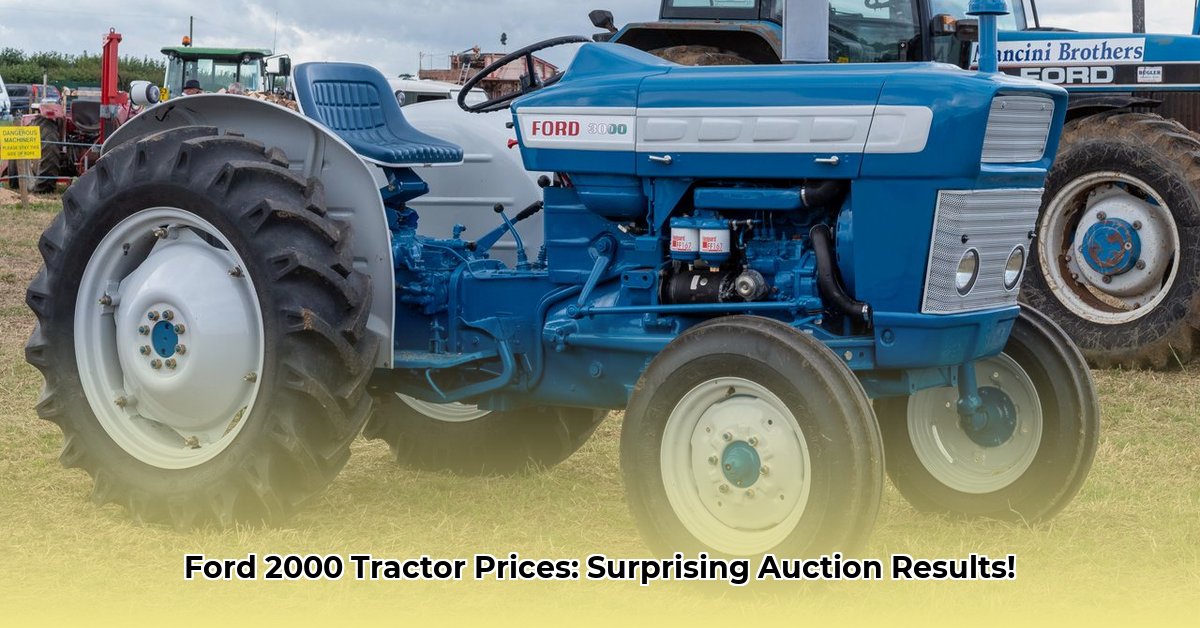
The Ford 2000 tractor, a stalwart of the 1960s agricultural landscape, enjoys a robust presence in both the working farm and collector markets. However, determining its fair market value requires understanding several key factors that influence pricing, ranging from mechanical condition to regional demand. This guide will provide insights into Ford 2000 tractor pricing, helping both potential buyers and seasoned collectors navigate this dynamic market. For more in-depth information on Ford tractors, check out this helpful resource.
Understanding the Ford 2000: Features and Variations
The Ford 2000 isn't a single entity; it encompasses a range of variations impacting its value. Engine options included both gasoline and diesel powerplants, with horsepower outputs ranging from approximately 36 to nearly 50 hp. Transmission choices were equally varied, spanning 4-speed, 5-speed, 10-speed, and even 12-speed configurations. The availability of implements like front-end loaders further adds to the complexity of assessing a Ford 2000's worth. A rare combination of features in pristine condition can significantly elevate its price. But what’s the difference between a tractor used by a farmer and one cherished by a collector?
Collectors vs. Farmers: Divergent Priorities, Varying Prices
The Ford 2000 market caters to two distinct groups: collectors and working farmers. Collectors view these tractors as pieces of agricultural history, seeking out original, well-preserved models, often prioritizing rarity and condition over operational capabilities. In contrast, farmers prioritize functionality and reliability, weighing the tractor's working condition against its cost. This divergence in priorities generates a broad price spectrum. Collectors drive up prices for exceptional specimens, while farmers focus on value for their immediate operational needs. This difference is key to understanding the price fluctuations seen in the market. How does this translate into actionable steps when buying one?
Buying a Ford Tractor 2000: A Practical Guide
Purchasing a Ford 2000 requires diligence and a methodical approach. Following these steps will substantially enhance the chances of a successful acquisition:
Thorough Pre-Purchase Inspection: A comprehensive inspection is paramount. Check for rust, significant wear, and any signs of mechanical issues. Inspect fluids, test various components, and consider engaging a qualified mechanic for a professional evaluation. Ignoring this can lead to costly post-purchase repairs.
Informed Price Negotiation: Research recent sales of comparable Ford 2000 tractors to establish a realistic market value. Use this data to inform your negotiation strategy, setting a firm budget and refusing to overpay. Respectful and reasonable negotiation is crucial, but knowing your limits protects you from potential losses.
Sourcing Parts: A Multifaceted Approach: Acquiring parts for older tractors can be challenging. Online marketplaces (like eBay or specialized agricultural parts sites), classic tractor parts suppliers, and online forums dedicated to Ford tractors offer diverse avenues for sourcing necessary components. Engaging with the Ford tractor community through these forums often unearths parts leads and invaluable insights from experienced owners.
Restoration Cost Assessment: If purchasing a Ford 2000 that requires restoration, carefully estimate the costs involved. This includes parts, labor (if outsourcing), and specialized tools. Weigh the potential increase in value to validate the investment of time and funds.
Ford Tractor 2000 Prices: A Market Snapshot
The following table provides a general price range, noting that actual prices fluctuate based on various factors including location, condition, and specific features.
| Condition | Price Range (USD) | Notes |
|---|---|---|
| Excellent | $6,000 - $9,000+ | Extremely rare; highly sought after by collectors; often museum-quality |
| Good | $3,000 - $6,000 | Mechanically sound; may require minor cosmetic or functional repairs |
| Fair | $1,000 - $3,000 | Needs more significant repairs or restoration work; sourcing parts may be challenging |
| Poor | Under $1,000 | Primarily for parts; requires extensive restoration |
Final Thoughts: A Market Rich in History
The Ford 2000 tractor market is dynamic and influenced by factors such as condition, restoration, and regional demand. Thorough research, careful consideration of your needs and budget, and a methodical purchase approach are critical for success. Remember that patience and due diligence will yield the best results, whether you’re a collector or a working farmer. The Ford 2000’s enduring appeal lies in its versatility as a working machine and its iconic status in agricultural history, thus ensuring its continued relevance in the classic tractor market.
While this guide provides a robust summary of the Ford 2000's market dynamics, remember additional research, including consulting with experienced mechanics and classic tractor enthusiasts, will greatly benefit your decision-making process.